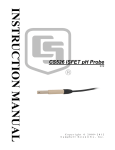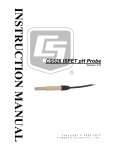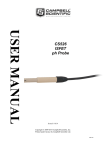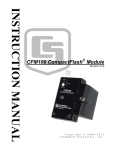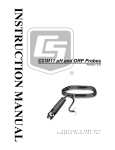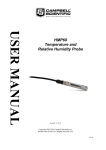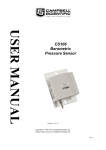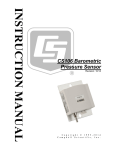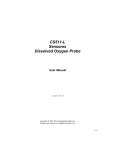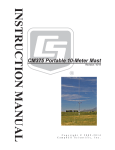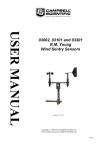Download Campbell CS525 Specifications
Transcript
CS525 ISFET pH Probe Revision: 10/11 C o p y r i g h t © 2 0 0 9 - 2 0 1 1 C a m p b e l l S c i e n t i f i c , I n c . WARRANTY AND ASSISTANCE This equipment is warranted by CAMPBELL SCIENTIFIC (CANADA) CORP. (“CSC”) to be free from defects in materials and workmanship under normal use and service for twelve (12) months from date of shipment unless specified otherwise. ***** Batteries are not warranted. ***** CSC's obligation under this warranty is limited to repairing or replacing (at CSC's option) defective products. The customer shall assume all costs of removing, reinstalling, and shipping defective products to CSC. CSC will return such products by surface carrier prepaid. This warranty shall not apply to any CSC products which have been subjected to modification, misuse, neglect, accidents of nature, or shipping damage. This warranty is in lieu of all other warranties, expressed or implied, including warranties of merchantability or fitness for a particular purpose. CSC is not liable for special, indirect, incidental, or consequential damages. Products may not be returned without prior authorization. To obtain a Return Merchandise Authorization (RMA), contact CAMPBELL SCIENTIFIC (CANADA) CORP., at (780) 454-2505. An RMA number will be issued in order to facilitate Repair Personnel in identifying an instrument upon arrival. Please write this number clearly on the outside of the shipping container. Include description of symptoms and all pertinent details. CAMPBELL SCIENTIFIC (CANADA) CORP. does not accept collect calls. Non-warranty products returned for repair should be accompanied by a purchase order to cover repair costs. PLEASE READ FIRST About this manual Please note that this manual was originally produced by Campbell Scientific Inc. (CSI) primarily for the US market. Some spellings, weights and measures may reflect this origin. Some useful conversion factors: Area: 1 in2 (square inch) = 645 mm2 Length: 1 in. (inch) = 25.4 mm 1 ft (foot) = 304.8 mm 1 yard = 0.914 m 1 mile = 1.609 km Mass: 1 oz. (ounce) = 28.35 g 1 lb (pound weight) = 0.454 kg Pressure: 1 psi (lb/in2) = 68.95 mb Volume: 1 US gallon = 3.785 litres In addition, part ordering numbers may vary. For example, the CABLE5CBL is a CSI part number and known as a FIN5COND at Campbell Scientific Canada (CSC). CSC Technical Support will be pleased to assist with any questions. CS525 Table of Contents PDF viewers: These page numbers refer to the printed version of this document. Use the PDF reader bookmarks tab for links to specific sections. 1. Introduction..................................................................1 1.1 Initial Inspection and Handling Guidelines ..............................................2 2. Specifications ..............................................................2 3. Installation and Wiring ................................................3 3.1 Preparation for Use...................................................................................3 3.2 Wiring.......................................................................................................3 4. Programming ...............................................................4 4.1 Using SCWIN for CR800, CR850, CR1000, and CR3000 ......................4 4.2 Using CRBasic .........................................................................................4 4.2.1 Simple Program ..............................................................................4 4.2.1.1 CR200(X) Programming .......................................................4 4.2.1.2 CR800, CR850, CR1000, and CR3000 Programming ..........5 4.2.2 Programming for calibration...........................................................6 5. Calibration ....................................................................6 6. Maintenance .................................................................6 6.1 Cleaning....................................................................................................7 7. Troubleshooting ..........................................................8 Appendix A. Calibration ............................................................... A-1 Figure 6-1. Tip of the CS525 Probe...........................................................................7 Tables 3-1. CR800, CR850, CR1000, and CR3000 Wiring.......................................3 3-2. CR200(X) Series Wiring .........................................................................4 i CS525 ISFET pH Probe The CS525 probe is designed for general pH measurements in aqueous or semi-solid solutions. It provides a 0 to 5 Vdc output that represents a 0 to 14 pH range. CAUTION The CS525-L ISFET pH Sensor is highly susceptible to ground looping and galvanic conditions. In many cases this can be isolated by NOT grounding the datalogger to an earth ground. However, the most successful isolation technique to overcome these issues is to use the CWS900 Wireless Sensor Interface. Please discuss the application with a CSI applications engineer before purchasing the sensor. 1. Introduction The submersible CS525 is designed to provide a rugged, reliable, accurate pH measurement that is fully temperature compensated. The pH-sensitive element in the CS525 is SENTRON's high-tech Ion Sensitive Field Effect Transistor (ISFET) semi-conductor and includes a silver/silverchloride - potassium chloride reference system. This technology is the most significant breakthrough in pH testing in half a century and is the most powerful pH testing technology available today. The ISFET proves its power under demanding circumstances where high solids, more aggressive chemicals or biological materials are present and clogging or junction contamination may occur. The probe is easily cleaned using a simple toothbrush. The CS525 electronics are safely embedded in the sensor body which is made of durable PEEK material. Due to the elimination of the glass-bulb, the possibility of broken glass is eliminated. The ISFET design considerably reduces the number of acidic or alkaline errors in extreme pH conditions. This rugged design makes the CS525 suitable for just about any liquids applications, from laboratory to harsh field applications. x Safety. The ISFET with durable PEEK material can be used safely in areas where broken glass is a hazard to the user. x Intelligent electronics. CS525 combines the latest developments in ISFET pH sensor technology with state-of-the-art sensor signal processing. This allows for accurate, fast and reliable results. x Quality. Designed and manufactured under stringent quality control conditions in an ISO 9001 environment. Each sensor is individually tested to the most demanding testing protocols, and the electronics comply fully directives and with EMC standard IEC61326:2005. with This sensing element is driven by an electronic circuit that is built into the handle of the probe. The CS525 can only perform up to its specifications if 1 CS525 ISFET pH Probe connected in the correct way to the datalogger. Any other combinations might cause a loss of performance and irreversible damage to both probe and/or datalogger. 1.1 Initial Inspection and Handling Guidelines Upon receipt of the CS525, inspect the packaging for any signs of shipping damage, and, if found, report the damage to the carrier in accordance with policy. The contents of the package should also be inspected and a claim filed if any shipping related damage is discovered. Care should be taken when opening the package not to damage or cut the cable jacket. If there is any question about damage having been caused to the cable jacket, a thorough inspection is prudent. The model number and cable length is printed on the cable label. Check this information against the shipping documentation to ensure that the expected model number and cable length were received. Remember that although the CS525 is designed to be a rugged and reliable device for field use, it is also a highly precise scientific instrument and should be handled as such. There are no user serviceable parts and any attempt to disassemble the device will void the warranty. 2. Specifications pH Range: 0 to 14 Power Requirements: 4.5 to 5.5 Vdc Power Consumption: Supply current: 2 mA nominal Measurement Time: 200 msec < t67% < 500 msec Output: A) 0 mV to +5000 mV +2700 mV at pH7 at 25qC with a sensitivity of 270 mV to 330 mV/pH at 25qC B) ±400 mV with a sensitivity of -45 mV to -50 mV/pH at 25qC 2 Accuracy: ±0.1 pH with 2 point calibration Operating Temperature: 0 to 70° C Maximum Cable Length: 300 m (1000 ft) Cable Type: three-twisted pair, 24 awg cable with Santoprene jacket Sensor Material: PEEK Dimensions: Length 190 mm (7.48 inches) Diameter 16 mm (0.63 inches) Weight w/10 ft Cable: 318 g (11.2 oz) Allowed Water Pressure: 0 to 700 kPa (0 to 101.5 psi) CS525 ISFET pH Probe 3. Installation and Wiring NOTE Campbell Scientific only offered the 0 to 5000 mV output range for CS525 probes ordered before January 2010. These probes had four wires instead of five. Wire colors were red (signal), black (power), white (signal reference), and clear (shield). 3.1 Preparation for Use The CS525 is shipped dry. Before the probe can be calibrated, soak it in 7 pH buffer solution for 15 minutes. Unlike many glass-bulb type pH sensors, the CS525 ISFET pH probe can be installed without regard to orientation. 3.2 Wiring The CS525 has two output range options: 0 to 5000 mV or ±400 mV. Select the output option that best fits the measurement range of the data acquisition device used. Campbell Scientific’s CR800, CR850, CR1000, and CR3000 can measure several output ranges. With these dataloggers, either the 0 to 5000 mV output or ±400 mV output can be chosen for the CS525. Connect the CS525 to the CR800, CR850, CR1000, and CR3000 based on the probe’s output option (see Table 3-1). TABLE 3-1. CR800, CR850, CR1000, and CR3000 Wiring Wire Color Wire Label/Function Red Power 5 Vdc Black Signal Reference White Signal Green Signal Clear Shield Datalogger Connections 0 to 5000 mV ±400 mV 5V 5V SE SE G G The CR200(X)-series dataloggers can only measure the 0 to 2500 mV output range. To accommodate this limitation, choose the 0 to 5000 mV output option for the CS525, and then use a VDIV2:1 to divide the sensor’s 5 Vdc output to 2.5 Vdc (see Table 3-2). 3 CS525 ISFET pH Probe TABLE 3-2. CR200(X) Series Wiring Wire Color Wire Label/Function VDIV2:1* Red Power 5 Vdc Black Signal Reference G White Signal H Clear Shield CR200(X) Series EX SE G *When using the VDIV2:1 with the CR200(X)-series datalogger, the L peg of the VDIV2:1 is not used and can be removed. 4. Programming 4.1 Using SCWIN for CR800, CR850, CR1000, and CR3000 In SCWIN, the CS525 is programmed by selecting single-ended voltage under Generic Measurements. SCWIN is the easiest and typically the preferred method for programming the datalogger. SCWIN generates a wiring diagram that shows how to connect the CS525 to your Campbell Scientific datalogger. NOTE The sections that immediately follow are for CRBasic users. SCWIN users can jump ahead to the Calibration section. 4.2 Using CRBasic 4.2.1 Simple Program 4.2.1.1 CR200(X) Programming The CS525 does not require constant power. To conserve power, the datalogger can be programmed to power the CS525 prior to the measurement, shut off. This function can be accomplished using the ExDelSE instruction of a CR200(X) datalogger. A multiplier of 1.0 and an offset of 0.0 yields millivolts. A corrected multiplier and an offset are required to provide an output in pH units (see Appendix A). The ExDelSE instruction has the following format: ExDelSE(Dest,Reps,SEChan,ExChan,ExmV,Delay,Mult,Offset ) This example program uses the ExDelSE instruction to apply a voltage to excitation channel one, delay for 30 milliseconds, and then make a measurement on single-ended analog channel one. 4 CS525 ISFET pH Probe ‘CR200(X) Series ‘Declare the variable for the pH measurement Public pHmV ‘Read sensor every 60 seconds BeginProg Scan(60,sec) ‘Turn power on, delay for 30000 microseconds, then measure sensor ExDelSE(pHmV,1,1,Ex1,mV5000,30000,1,0.0) NextScan EndProg 4.2.1.2 CR800, CR850, CR1000, and CR3000 Programming For the CR800, CR1000 and CR3000 dataloggers, Instruction VoltSe is used to read Single-ended analog sensors. A multiplier of 1.0 and an offset of 0.0 yields millivolts. A corrected multiplier and an offset are required to provide an output in pH units (see Appendix A). The VoltSe instruction has the following form: VoltSe(Dest, Reps, Range, SEChan, MeasOff, SettlingTime, Integ, Mult, Offset) Use mV5000 for the range parameter if the sensor’s output option is 0 to 5000 mV. Typically, use mV250 for the range parameter if the sensor’s output option is r300 mV. NOTE The mV250 range option may be inadequate for pH ranges that are greater than 11 or less than 2. At these extreme ranges, either use Autorange or mV5000. Below is an example program for CR800, CR850, CR1000, and CR3000 dataloggers when the sensor has a 0 to 5000 mV output. ‘CR1000 Series Datalogger ‘Declare the variable for the pH measurement Public pHmV ‘Read sensor every 60 seconds BeginProg Scan(60,sec,1,0) ‘ Code for VoltSE measurements: VoltSE(pHmV,1, mV5000,1,False,0,_60Hz,1,0) NextScan EndProg 5 CS525 ISFET pH Probe Below is an example program for CR800, CR850, CR1000, and CR3000 dataloggers when the sensor has a ±400 mV output (see Note below). ‘CR1000 Series Datalogger ‘Declare the variable for the pH measurement Public pHmV ‘Read sensor every 60 seconds BeginProg Scan(60,sec,1,0) ‘Code for VoltSE measurements: VoltSE(pHmV,1, mV250,1,False,0,_60Hz,1,0) NextScan EndProg NOTE The mV250 range option may be inadequate for pH ranges that are greater than 11 or less than 2. At these extreme ranges, either use Autorange or mV5000. 4.2.2 Programming for calibration In order to output in pH units instead of mV, the offset and multiplier need to be entered in the datalogger programming. Also, because of the need to periodically calibrate the pH reading, simple program instructions can be used to make this process simple. See Appendix A for an example program. 5. Calibration Calibration should be carried out according to the detailed procedure outlined in Appendix A. The calibration should use two or more pH standards (pH4 CSI PN 25587, pH7 CSI PN 25586, and pH10 CSI PN 25588). The frequency of calibration will depend on the level of accuracy required and the coating/fouling nature of the samples being measured. 6. Maintenance Campbell Scientific recommends that the CS525 be cleaned and calibrated periodically to insure accurate readings. If the CS525 is not operating properly and requires return to Campbell Scientific, the customer must get an RMA (returned material authorization) and fill out the Declaration of Hazardous Material and Decontamination form. This information can be obtained from http://www.campbellsci.com/repair. 6 CS525 ISFET pH Probe The CS525 has no user-serviceable parts. Cable can be damaged by abrasion, rodents, sharp objects, twisting, crimping or crushing and pulling. Take care during installation and use to avoid cable damage. 6.1 Cleaning It is possible that contamination on the diaphragm will block the built-in reference electrode. In that case there will be no electrical contact between the electrode and the ISFET chip and the probe will not function. To prevent this, regular cleaning is recommended. The required frequency of cleaning depends on the quality of the water. The best cleaning method is the following “soapy water method”: CAUTION 1. Place the tip of the probe in soapy water that is 50q to 60qC and soak for about 5 minutes (see Figure 6-1). 2. Rinse thoroughly with deionized water. 3. If necessary, lightly scrub the tip of the probe with a toothbrush to remove debris (see Caution). 4. Place the probe in saturated KC1 solution (CSI PN 16349) at about 20qC. Keep probe in solution for about 30 minutes. To prevent scratching the chip, a toothbrush should only be used after soaking in soapy water. Most scratches occur when hard particles are rubbed with a toothbrush on the chip surface. This can cause irreversible damage to the probe. 5. Rinse the probe. 6. Calibrate the probe (see Appendix A). Diaphragm Chip FIGURE 6-1. Tip of the CS525 Probe 7 CS525 ISFET pH Probe 7. Troubleshooting The most common causes for erroneous pH data include: x x x poor sensor connections to the datalogger damaged cables scratched chip Problem: Output signal is at its maximum value. Possible reason: x x x x Probe is not in fluid. Chip is polluted. Diaphragm is polluted. Chip is scratched. Suggestion: x x x Put probe in fluid. Clean probe using soapy water method. Probe can not be fixed if chip is scratched. Problem: Probe response is very slow. Possible reason: x Diaphragm is chipped or polluted Suggestion: x Clean probe with soapy water method. Problem: Probe signal is drifting. Possible reason: x x Diaphragm can be dried out. Chip is scratched. Suggestion: x x 8 Soak probe for 10 minutes in saturated KC1 solution (CSI PN 16349). Probe can not be fixed. Appendix A. Calibration This calibration process uses a 7 pH and 4 pH buffer solution (CSI part number). After downloading the following example program onto the datalogger, and insuring that the CS525 is properly wired to the datalogger, the operator would use the Numeric Display found in the software PC200W, PC400, LoggerNet, PConnect, and PConnectCE, to: 1. Place the CS525 into a pH 7 buffer solution (CSI PN 25586). 2. Allow the pHmV reading to stabilize. 3. Change the value in pH7record to -1. 4. Remove the CS525 from the pH7 buffer solution and rinse with deionized water. 5. Blot dry the CS525 with a soft cloth or paper towel. 6. Place the CS525 in a pH 4 buffer solution (CSI PN 25587). 7. Allow the pHmV reading to stabilize. 8. Change the value in pH4record to -1. 9. Change the value in pHcal to -1. 10. The CS525 is now ready to be place in the solution to be measured. The simple example program to provide this two point pH calibration process would be: PreserveVariables ‘Define Variables Public batt_volt, pH, pHmV Public pHcal, pH4record, pH7record Dim pHmult,pHoffset Dim pH4mV,pH7mV 'Define Data Tables DataTable (TenMin,1,-1) DataInterval (0,10,min,10) Average (1,pH,FP2,False) EndTable 'Main Program BeginProg Scan (10,Sec,3,0) A-1 Appendix A. Calibration Battery (Batt_volt) VoltSe (pHmV,1,mV5000,1,False,0,_60Hz,1,0) If pH4record = -1 Then pH4mV = pHmV pH4record = 0 EndIf If pH7record = -1 Then pH7mV = pHmV pH7record = 0 EndIf If pHcal = -1 Then pHmult = 3/(pH7mV - pH4mV) pHoffset = 7 - pHmult * pH7mV pHcal = 0 EndIf pH = pHmult * pHmV + pHoffset CallTable TenMin NextScan EndProg A-2 Campbell Scientific Companies Campbell Scientific, Inc. (CSI) 815 West 1800 North Logan, Utah 84321 UNITED STATES www.campbellsci.com • [email protected] Campbell Scientific Africa Pty. Ltd. (CSAf) PO Box 2450 Somerset West 7129 SOUTH AFRICA www.csafrica.co.za • [email protected] Campbell Scientific Australia Pty. Ltd. (CSA) PO Box 444 Thuringowa Central QLD 4812 AUSTRALIA www.campbellsci.com.au • [email protected] Campbell Scientific do Brazil Ltda. (CSB) Rua Luisa Crapsi Orsi, 15 Butantã CEP: 005543-000 São Paulo SP BRAZIL www.campbellsci.com.br • [email protected] Campbell Scientific Canada Corp. (CSC) 11564 - 149th Street NW Edmonton, Alberta T5M 1W7 CANADA www.campbellsci.ca • [email protected] Campbell Scientific Centro Caribe S.A. (CSCC) 300 N Cementerio, Edificio Breller Santo Domingo, Heredia 40305 COSTA RICA www.campbellsci.cc • [email protected] Campbell Scientific Ltd. (CSL) Campbell Park 80 Hathern Road Shepshed, Loughborough LE12 9GX UNITED KINGDOM www.campbellsci.co.uk • [email protected] Campbell Scientific Ltd. (France) 3 Avenue de la Division Leclerc 92160 ANTONY FRANCE www.campbellsci.fr • [email protected] Campbell Scientific Spain, S. L. Avda. Pompeu Fabra 7-9, local 1 08024 Barcelona SPAIN www.campbellsci.es • [email protected] Please visit www.campbellsci.com to obtain contact information for your local US or International representative.


















